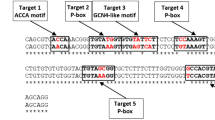Abstract.
To study the export of sugars from leaves and their long-distance transport, sucrose-proton/co-transporter activity of potato was inhibited by antisense repression of StSUT1 under control of either a ubiquitously active (CaMV 35S ) or a companion-cell-specific (rolC) promotor in transgenic plants. Transformants exhibiting reduced levels of the sucrose-transporter mRNA and showing a dramatic reduction in root and tuber growth, were chosen to investigate the ultrastructure of their source leaves. The transformants had a regular leaf anatomy with a single-layered palisade parenchyma, and bicollateral minor veins within the spongy parenchyma. Regardless of the promoter used, source leaves from transformants showed an altered leaf phenotype and a permanent accumulation of assimilates as indicated by the number and size of starch grains, and by the occurrence of lipid-storing oleosomes. Starch accumulated throughout the leaf: in epidermis, mesophyll and, to a smaller degree, in phloem parenchyma cells of minor veins. Oleosomes were observed equally in mesophyll and phloem parenchyma cells. Companion cells were not involved in lipid accmulation and their chloroplasts developed only small starch grains. The similarity of ultrastructural symptoms under both promotors corresponds to, rather than contradicts, the hypothesis that assimilates can move symplasmically from mesophyll, via the bundle sheath, up to the phloem. The microscopical symptoms of a constitutively high sugar level in the transformant leaves were compared with those in wild-type plants after cold-girdling of the petiole. Inhibition of sugar export, both by a reduction of sucrose carriers in the sieve element/companion cell complex (se/cc complex), or further downstream by cold-girdling, equally evokes the accumulation of assimilates in all leaf tissues up to the se/cc complex border. However, microscopy revealed that antisense inhibition of loading produces a persistently high sugar level throughout the leaf, while cold-girdling leads only to local patches containing high levels of sugar.
Similar content being viewed by others
Author information
Authors and Affiliations
Additional information
Received: 4 March 1998 / Accepted: 7 April 1998
Rights and permissions
About this article
Cite this article
Schulz, A., Kühn, C., Riesmeier, J. et al. Ultrastructural effects in potato leaves due to antisense-inhibition of the sucrose transporter indicate an apoplasmic mode of phloem loading. Planta 206, 533–543 (1998). https://doi.org/10.1007/s004250050430
Issue Date:
DOI: https://doi.org/10.1007/s004250050430




